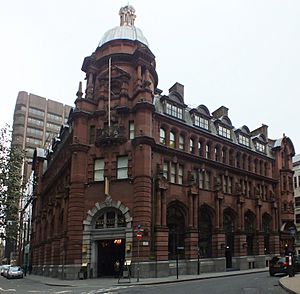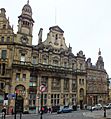Spring Gardens, Manchester facts for kids
Spring Gardens is a well-known street in the heart of Manchester city centre, England. This L-shaped street was once a very important place for banks in the North West of England. It has five buildings that are listed as Grade II, meaning they are historically important and protected. It's also part of a special area called the Upper King Street conservation area.
Contents
Exploring Spring Gardens
Spring Gardens starts where Charlotte Street meets West Mosley Street. It crosses Fountain Street and Concert Lane, then continues north towards the eastern end of King Street. Cars can't go all the way north on Spring Gardens because of a one-way system, but people walking can easily continue north to reach Market Street, which is a busy shopping area.
Amazing Buildings to See
Five of the buildings on Spring Gardens are listed as Grade II. This means they are very important and protected because of their history or special design.
Buildings on the West Side
- Tootal House: This building was designed by John Radcliffe and Associates in 1982.
- Lowry House: Built between 1975 and 1976 by Arthur Smith and Associates, it has a tall tower that is about 58 meters (190 feet) high!
- Numbers 60 and 62: This building was once a warehouse, built a long time ago in 1881–1883 by a famous architect named Alfred Waterhouse. It later became home to Minster Insurance and is now a Grade II listed building.
Buildings on the East Side
- The Post Office: Designed by Cruikshank & Seward in 1969, there has been a post office on Spring Gardens since way back in 1623! When this building was finished, it was the biggest post office in the north of England. Inside, the upper walls have cool, bold panels made of fibreglass.
- Amethyst House: This building was designed by Howitt and Tucker in 1973.
- 1 York Street: This grand building used to be Parr's Bank. It was built in 1902 by Charles Heathcote and is considered a Grade II* listed building, which means it's extra special!
- Number 41: This building was also designed by Alfred Waterhouse between 1888 and 1890 for the National Provincial Bank. It's a Grade II listed building.
- Numbers 43 and 45: This building was home to the Lancashire & Yorkshire Bank and was built in 1890 by Heathcote & Rawle.
- Number 47: Built by Charles Heathcote in 1881, this building was originally for the Commercial Union Assurance Society and later became a Barclay's Bank. It is a Grade II listed building.
- Number 49: This building was once a warehouse, designed by Clegg & Knowles in 1879. It is also a Grade II listed building.
Images for kids



